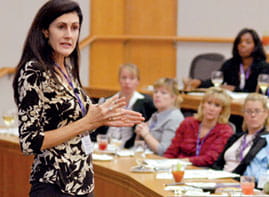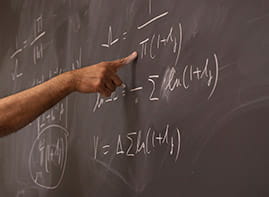Schwartz Lecturer Drew Fudenberg explains how learning plays a role in games — and what that means for Nash equilibrium
4/22/2009 - Game theorists have studied the concept of Nash equilibrium since it was defined by mathematician and economist John Forbes Nash in 1950.
But what is Nash equilibrium? And how does it fit into the “games” that theorists study?
Drew Fudenberg, the Frederick E. Abbe Professor of Economics at Harvard University, addressed both questions during his April 15 talk, “Learning in Games,” at the Kellogg School. A renowned scholar of game theory, Fudenberg was the invited speaker at the school’s 2009 Nancy L. Schwartz Memorial Lecture. The annual series addresses important issues in current economic theory.
The first half of Fudenberg’s lecture was intended to be accessible to a general audience, and he began his talk with a brief history of game theory. A mathematical science that studies behavior in strategic situations, the field was established in 1944 when John von Neumann and Oskar Morgenstern published
Theory of Games and Economic Behavior. The tools of game theory are now applied most frequently in economics, biology, engineering, political science and computer science.
A “game” has two or more players who must choose between a set of strategies, with each strategy resulting in a specific payoff, Fudenberg explained. As an example, he cited Jean-Jacques Rousseau’s “stag hunt game,” in which hunters in a forest must decide between collectively hunting a stag — and potentially sharing a large payoff — or independently setting a rabbit trap, and receiving a smaller payoff. Capturing the stag requires cooperation from all hunters, while hunting the rabbit independently does not.
In this example, if everyone’s strategy is to go after the stag, and there are sufficient hunters, it makes sense for every hunter to participate in capturing the stag. On the other hand, if some hunters pursue the rabbits, there will be an insufficient number of hunters chasing the stag. The hunters, then, would lose the incentive to hunt the stag. In other words, “Nash equilibrium is the strategy profile where each player’s strategy maximizes that player’s payoff, given the strategies used by the other players,” Fudenberg said. “That is, no player can get a higher payoff by changing their own strategy, holding fixed the strategies of other players.”
In most games, Nash equilibrium is reached after players play several times and learn from the outcome. “You start off not having equilibrium, but by repeated play and having common observations, you end up at Nash equilibrium,” Fudenberg said.
However, in “dynamic games,” as opposed to “static games,” players move sequentially multiple times and learn from their moves. In these games, “before the agent plays the game, he thinks about every possible solution that could possibly arise in the play of the game, and decides how he would play in that situation,” said Fudenberg.
In these instances, “instead of Nash equilibrium, other equilibrium concepts would be more appropriate,” said Fudenberg. “The nature of equilibrium — what the right equilibrium concept is — should be a theorem. It should be derived from assumptions about the learning process, as opposed to an axiom.” Fudenberg proceeded to illustrate such examples in which what he calls “self-confirming equilibrium” emerges as the right solution concept.
The Nancy L. Schwartz Memorial Lecture series was founded in 1983 by the family members, colleagues and friends of Nancy L. Schwartz, the Morrison Professor of Decision Sciences and the first female faculty member appointed to an endowed chair at the Kellogg School. Eleven of the 26 speakers featured at the Nancy L. Schwartz Memorial Lecture have won the Nobel Prize. The lecture series is administered by the Kellogg School’s Center of Game Theory and Economic Behavior and housed within the school’s Department of Managerial Economics and Decision Sciences.






